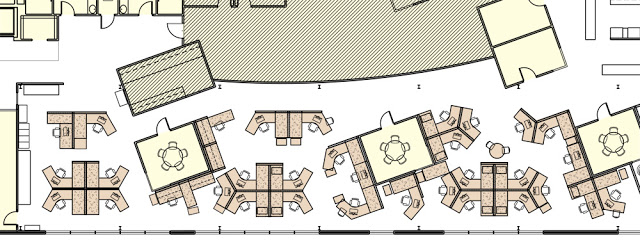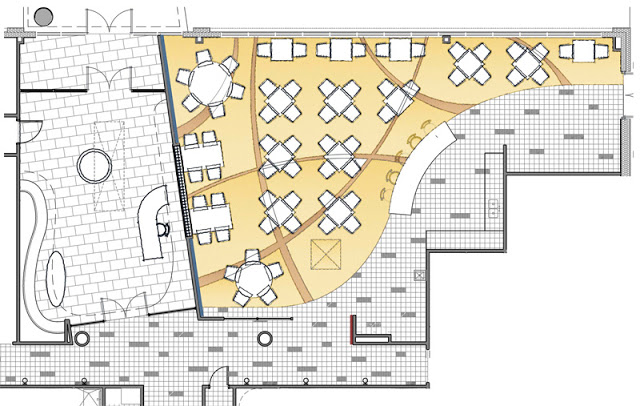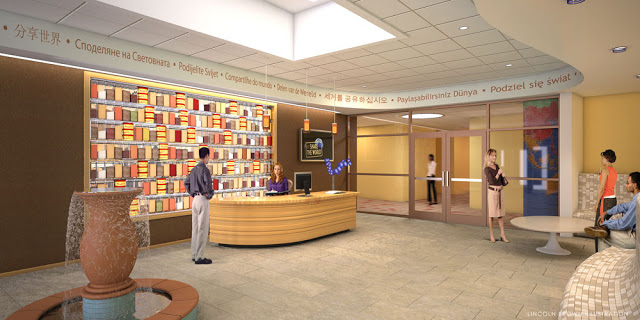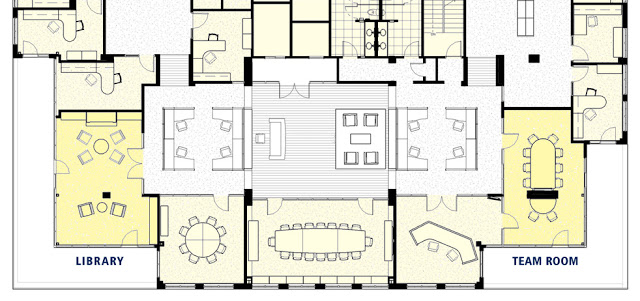Collaboration in the Workplace
The biggest buzzword in workplace design these days is collaboration. And for good reason: the nature of the workplace is changing, with an increased focus on teamwork and informal interaction.
There are many factors driving this change. Younger Gen X and Gen Y workers tend to be more social, and more comfortable working in groups. Advancements in technology have eliminated some of the traditional constraints of space use, such as being tethered to a desk. And organizations everywhere are dealing with an economy that begs for a more productive use of real estate.
Collaboration is not the same thing as attending a formal meeting. The kind of workplace collaboration that we are talking about is the spontaneous, informal interaction that occurs between coworkers at unplanned moments. There is an increased recognition that the most creative problem-solving does not occur by an individual behind closed doors, but rather by a group effort of people putting their heads together.
Private space for concentrated work is still needed, but the traditional office and meeting room are increasingly being supplemented by more flexible, open spaces that allow for spontaneous collaboration.
Here are three examples from some recent projects of ours that we designed to facilitate collaboration in the workplace. For these examples, we will look at three different space types: an open office area; an employee cafeteria; and a pair of nontraditional meeting rooms.
AN ORGANIC PLAN
The conventional office cubicle is not very conducive to group work. Partitions are too high for interacting with your neighbor in any meaningful way, and the repetitive rows of desks and panels stifle individuality and creativity.
At the Institute for Sustainable Communities, we designed a workplace environment that breaks out of the “cubicles” box and promotes collaboration through the creation of “in-between” spaces. (click to enlarge)
The ISC is a global non-profit organization that helps communities around the world address environmental, economic and social challenges. At their headquarters in Montpelier, we designed an office landscape using new and reused components in a seemingly random pattern. Unlike a conventional plan, where rows of workstations mean everyone sits facing the same direction, at the ISC the desks are arranged so that each workstation is spatially unique.
This layout accomplishes a few things. By breaking the line of sight and giving each person a unique perspective, a certain sense of privacy is achieved, without having to resort to 60” high panels.
The scattered layout also creates plenty of “in-between” spaces that welcome collaboration. Here, it is not necessary to walk into someone’s personal space to speak with them. And conversely, the spaces in-between do not feel like a regular hallway that says “keep walking”. The in-between spaces are welcoming to someone who’d like to pull up a chair or simply ask a question.
The ISC is a non-profit organization, so maximizing their space was very important. According to conventional logic, any plan that varies from a regular grid of cubicles will automatically be less efficient. This plan proves that this need not be the case. The “irregular” layout here actually provided more seating than what they previously had. This is partly due to a more efficient use of circulation space. By blurring the edges around the workstations, we were able to “steal” the adjoining circulation space and claim it for dedicated workspace.
I also love how organic this plan seems, a fitting attribute for a group that at its most basic level is helping communities grow.
FOOD FOR THOUGHT
Collaboration doesn’t have to occur at your desk or in a meeting room. In fact, the interactions that often yield the most creative results are those that happen unexpectedly, when two or more people exchange ideas while in a social setting such as a café or cafeteria.
It can also be most beneficial when people collaborate with others outside of their own working group. Coming together with people from different areas of a company can lead to a more complete and thought-out solution to a problem. (We see this also in educational institutions with the rise of interdisciplinary studies.)
TruexCullins recently served as the design architects for the new company headquarters of the Sabra Dipping Company. Their new LEED Silver-certified headquarters in Colonial Heights, Virginia employs 260 people in administration, research and development, and manufacturing. The facility includes office space, manufacturing and packaging, and a kitchen lab where they test new flavors of hummus, salsa, and dips.
So where is the one place that everyone can come together, regardless of whether they work in the offices, the labs, or on the factory floor? The company cafeteria.
The Sabra cafeteria is designed to be welcoming. There is no door. The layout of the corridor and the design of the materials on the floor and walls naturally lead you in to the space.
In fact, the cafeteria beckons you as soon as you enter the building. When entering the front reception area, guests and employees are met with a filtered view into the café through a glass display wall. These shelves are lined with canisters of colorful ingredients that are used in Sabra products.
Once inside the cafeteria, a variety of seating options allow for different kinds of casual meetings. The space is flooded with natural light, and the colors and forms make this a lively, engaging space. The curves inscribed into the marmoleum floor are a reference to the curves in the Sabra logo, reinforcing the company’s brand.
A curved bar with seating is located at the head of the room, which doubles as a presentation counter. This was designed to accommodate cooking demonstrations which would be televised. Lighting, background materials, and camera angles were all considered. Overall, it is an active, engaging, multi-purpose space that promotes collaboration among all Sabra employees and their guests.
ROOMS WITH A VIEW
The most valuable real estate in a commercial building has traditionally been the corner office. With views in two directions, this is a space that has status, prestige, and is usually beyond the reach of all but the top executives in a company.
The last of our three examples of workplace collaboration is from a tenant fit-up project for a local financial management firm. Their new offices are currently under construction in a downtown building on the top floor. The best real estate in this building is along the western side, with floor-to-ceiling storefront glazing that overlooks Lake Champlain. And of these spaces facing the lake, the best of the best are at the two corners, with sweeping panoramic views and direct access to outdoor rooftop terraces.
But instead of reserving these rooms for private offices, both corners are made available for everyone to use, consciously designed to foster collaboration, where people can be free and unburdened to work together dynamically.
At the northwest corner, the Library is a room for both private concentration and small group meetings. This is a casual space with comfortable seating, dimmable lighting, and a stone fireplace with built-in wood casework on each side for books and reference materials. It is a quiet space that offers a retreat from the main office. And with an all-glass façade and doors that open out to a rooftop terrace, it will surely become a destination for everyone who works here.
Rooms like this are important for informal meetings, where workers may feel they can discuss things more freely than in a formal meeting. And because it is a non-scheduled space, people can come together in a relaxed environment at a moment’s notice.
The counterpoint to this space is the “team room” at the southwest corner of the building. In this room, eight people work together around a peninsula-shaped table. A large LCD display is mounted to the wall at the head of the table. Through the use of special A/V equipment that is built into the table, each person can take the contents of their laptop or tablet and flip it up on to the big screen to share with the group. There is not a single moderator or presenter here. Rather, everyone comes to the table with an equal voice, made possible through both the technology and the physical design of the room and furniture.
There are a couple good off-the-shelf options available that provide systems like this. For this project, we brought together a Vermont furniture maker – Lyndon Furniture – with a local audio/visual company – Geer Sound – to come up with a custom solution.
A NEW WORKPLACE
All three of these examples deal with workplace collaboration in their own way, but they are all reflections of how the workplace today is changing. As a result of worker demographics, advancements in technology, and ongoing economic challenges, the office landscape is evolving to allow for more unencumbered and productive group collaboration.



